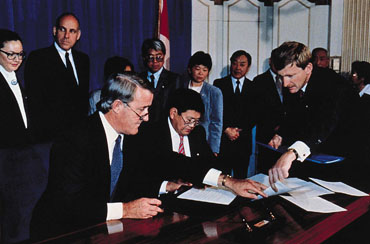
The War Measures Act was a federal law. It was passed by Parliament on 22 August 1914. The Act gave the federal government broad powers to maintain security and order during “war, invasion or insurrection.” The Act was used to suspend the civil liberties of “enemy aliens” during both world wars. This led to mass arrests, detentions and internment. The Act was also used during the 1970 October Crisis. The Act was replaced by the Emergencies Act in 1988.
(This article is a plain-language summary of the War Measures Act. If you are interested in reading about this topic in more depth, please see our full-length entry, War Measures Act.)

The federal government passed the War Measures Act at the start of the First World War. The Act was in force from 4 August 1914 to 10 January 1920. It gave sweeping powers to Cabinet. It allowed Cabinet to bypass the House of Commons and the Senate. Instead, it could govern by order-in-council (decree).
Under the Act, the government could censor and suppress communications. It could arrest, detain and deport people without charges or trials. It could control transportation, trade and manufacturing. It could also seize private property. People could be arrested and interned for their political beliefs.
During the war, thousands of people in Canada were seen as “enemy aliens.” This meant that they were from countries, or had roots in countries, that were at war with Canada. The War Measures Act was used to intern these people. During the war, 8,579 enemy aliens were interned in Canada. Just over 3,000 of these were prisoners of war. The rest were civilians. Internees had their property seized. They were often forced to work on labour projects. (See Ukrainian Internment in Canada.)

The debate over conscription divided the country. Riots over the issue broke out in Quebec. Between 28 March and 1 April 1918, the government used the War Measures Act to stop riots in Quebec City. Martial law was declared. More than 6,000 soldiers were deployed. The Easter Riots resulted in as many as 150 casualties.
The War Measures Act was again brought into force on 25 August 1939. It was used to implement the Defence of Canada Regulations. These allowed authorities to censor newspapers. Some religious, cultural and political groups were also banned. The Minister of Justice could detain anyone without due process. Any person who criticized the government could be interned without charge or trial.
As in the First World War, thousands of “enemy aliens” were interned. They included Italian Canadians, German Canadians, Jewish refugees and pacifist Mennonites. In 1942, around 22,000 Japanese Canadians were interned. They were stripped of their property. Many of them were forced to accept mass deportation when the war ended.

The War Measures Act was used only once during a domestic crisis. In October 1970, a state of “apprehended insurrection” was declared in Quebec. This was in response to two kidnappings by the terrorist group Front de Liberation du Quebec (FLQ). The FLQ was outlawed. Membership in the group became a crime. Police conducted more than 3,000 searches. Almost 500 people were detained. The suspension of civil liberties was highly controversial. (See October Crisis; The FLQ and the October Crisis Timeline.)
In the post-war period, Canadians who had been interned and who had their property seized began calling for compensation. The Japanese Canadian redress movement led to an official government apology in 1988. Financial compensation was also given to people affected by the Act during both world wars.

The War Measures Act was repealed in 1988. It was replaced by the Emergencies Act. This Act created more limited and specific powers to deal with security emergencies. Under the Act, Cabinet orders must be reviewed by Parliament. They must also be in accordance with the Canadian Charter of Rights and Freedoms and the Canadian Bill of Rights.